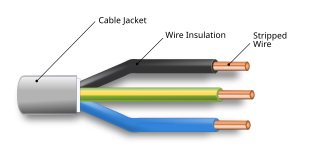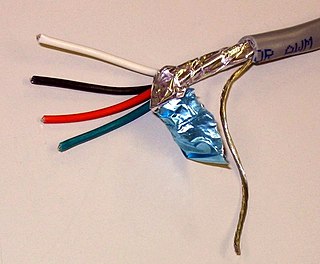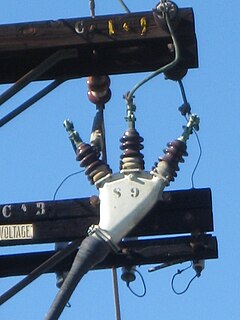Related Research Articles

An electrical insulator is a material whose internal electric charges do not flow freely; very little electric current will flow through it under the influence of an electric field. This contrasts with other materials, semiconductors and conductors, which conduct electric current more easily. The property that distinguishes an insulator is its resistivity; insulators have higher resistivity than semiconductors or conductors.

A wire is a single, usually cylindrical, flexible strand or rod of metal. Wires are used to bear mechanical loads or electricity and telecommunications signals. Wire is commonly formed by drawing the metal through a hole in a die or draw plate. Wire gauges come in various standard sizes, as expressed in terms of a gauge number. The term wire is also used more loosely to refer to a bundle of such strands, as in "multistranded wire", which is more correctly termed a wire rope in mechanics, or a cable in electricity.

An electrical cable is an assembly of one or more wires running side by side or bundled, which is used to carry electric current.

Coaxial cable, or coax is a type of electrical cable that has an inner conductor surrounded by a tubular insulating layer, surrounded by a tubular conducting shield. Many coaxial cables also have an insulating outer sheath or jacket. The term coaxial comes from the inner conductor and the outer shield sharing a geometric axis. Coaxial cable was invented by English engineer and mathematician Oliver Heaviside, who patented the design in 1880.

A high-voltage, direct current (HVDC) electric power transmission system uses direct current for the bulk transmission of electrical power, in contrast with the more common alternating current (AC) systems. For long-distance transmission, HVDC systems may be less expensive and suffer lower electrical losses. For underwater power cables, HVDC avoids the heavy currents required to charge and discharge the cable capacitance each cycle. For shorter distances, the higher cost of DC conversion equipment compared to an AC system may still be justified, due to other benefits of direct current links. HVDC uses voltages between 100 kV and 1,500 kV.
Electrical wiring in North America follows regulations and standards for installation of building wiring which ultimately provides mains electricity.

Electrical wiring is an electrical installation of cabling and associated devices such as switches, distribution boards, sockets, and light fittings in a structure.
Cable may refer to:

A shielded cable or screened cable is an electrical cable of one or more insulated conductors enclosed by a common conductive layer. The shield may be composed of braided strands of copper, a non-braided spiral winding of copper tape, or a layer of conducting polymer. Usually this shield is covered with a jacket.
Ampacity is a portmanteau for ampere capacity defined by National Electrical Codes, in some North American countries. Ampacity is defined as the maximum current, in amperes, that a conductor can carry continuously under the conditions of use without exceeding its temperature rating. Also described as current-carrying capacity.

Mineral-insulated copper-clad cable is a variety of electrical cable made from copper conductors inside a copper sheath, insulated by inorganic magnesium oxide powder. The name is often abbreviated to MICC or MI cable, and colloquially known as pyro. A similar product sheathed with metals other than copper is called mineral insulated metal sheathed (MIMS) cable.

In electrical engineering, treeing is an electrical pre-breakdown phenomenon in solid insulation. It is a damaging process due to partial discharges and progresses through the stressed dielectric insulation, in a path resembling the branches of a tree. Treeing of solid high-voltage cable insulation is a common breakdown mechanism and source of electrical faults in underground power cables.
Thermoplastic-sheathed cable (TPS) consists of an outer toughened sheath of polyvinyl chloride (PVC) covering one or more individual cables which are PVC insulated annealed copper conductors. It is a commonly used type of wiring for residential and light commercial construction in many countries. The flat version of the cable with two insulated conductors and an uninsulated earth conductor all within the outer sheath is referred to as twin and earth. In mainland Europe, a round equivalent is more common.

British Insulated Callender's Cables (BICC) was a 20th-century British cable manufacturer and construction company, now renamed after former subsidiary Balfour Beatty.
An aerial cable or air cable is an insulated cable usually containing all conductors required for an electrical distribution system or a telecommunication line, which is suspended between utility poles or electricity pylons. As aerial cables are completely insulated there is no danger of electric shock when touching them and there is no requirement for mounting them with insulators on pylons and poles. A further advantage is they require less right of way than overhead lines for the same reason. They can be designed as shielded cables for telecommunication purposes. If the cable falls, it may still operate if its insulation is not damaged.

A pothead is a type of insulated electrical terminal used for transitioning between overhead line and underground high voltage cable or for connecting overhead wiring to equipment like transformers. Its name comes from the process of potting or encapsulation of the conductors inside the terminal's insulating bushing.

A high-voltage cable is a cable used for electric power transmission at high voltage. A cable includes a conductor and insulation, and is suitable for being run underground or underwater. This is in contrast to an overhead line, which does not have insulation. High-voltage cables of differing types have a variety of applications in instruments, ignition systems, and alternating current (AC) and direct current (DC) power transmission. In all applications, the insulation of the cable must not deteriorate due to the high-voltage stress, ozone produced by electric discharges in air, or tracking. The cable system must prevent contact of the high-voltage conductor with other objects or persons, and must contain and control leakage current. Cable joints and terminals must be designed to control the high-voltage stress to prevent breakdown of the insulation. Often a high-voltage cable will have a metallic shield layer over the insulation, connected to the ground and designed to equalize the dielectric stress on the insulation layer.

Sir Thomas Octavius Callender was an engineer and businessman, who promoted the electrical industry.
References
- ↑ William A. Thue (ed.), Electrical Power Cable Engineering, Third Edition CRC Press, 2011 ISBN 1439856435 pages 203-204